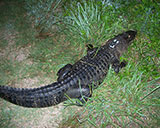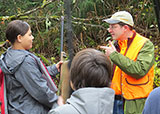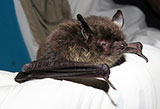Alaska Fish & Wildlife News
January 2018
From Alligators to Wolverines
Furbearer Biologist Appreciates Variety

Putting a tracking device on alligators is a challenge, but it has some advantages over collaring wolverines.
Wildlife biologist Dave Saalfeld earned his Ph.D. working with alligators in East Texas, and he’s now applying his expertise in spatial ecology and population dynamics to moose, wolves, black bears and wolverines in Alaska. He’s been a biologist with Fish and Game since 2013, working in Anchorage on a variety of projects. He expects to become more “furbearer-centric” ... Alligators to Wolves Article Continued
Hunter Education in Juneau Middle Schools

As a fishery biologist, I’m not generally expected to teach middle school. But as a new volunteer hunter education instructor, I found myself nervously walking into a Juneau school, ready to face a room full of sixth graders.
I volunteered to teach the Field Care of Game portion, since that was a familiar topic to me. Of course I was petrified to stand in front of a class of sixth graders. I wondered: would they behave? Be engaged in the topic? Would they like the videos and ... Hunter Education Article Continued
‘Swarming’ Behavior in Southeast Bats
Could Reveal Key Information on Hibernation Habits

Bat researcher Karen Blejwas has documented a behavior in the small, winged mammals that will not only help her hone in on their hard-to-find winter roosts, but it will also provide valuable insights into habitat selection, hibernation timing and emergence.
It’s called swarming. It happens every fall, as the bats congregate around their roosting sites either as part of mating behavior or to teach young bats where to find a decent hibernation site. The term “swarming” may ... Swarming Bats Article Continued
